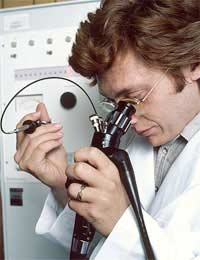Endoscopic Surgery for Throat

Endoscopic surgery is widely used in modern medicine. An endoscope is a thin tube into which is fitted a camera and a variety of surgical instruments and tools. It is both thin and flexible and can be introduced into the body through various natural openings, or through a small incision made in the body wall. Endoscopic surgery is also known as laparoscopic surgery or keyhole surgery.
What are the Benefits of Endoscopic Surgery?
Although endoscopic investigations and procedures are not the most pleasant experience that you can have, they are a lot safer and easier to recover from than major surgery. The use of endoscopic techniques in cardiology, for example, has made it possible to treat blocked coronary arteries in the heart using only a small incision in the blood vessel at the top of the leg. Balloon angioplasty and other techniques are all now done routinely by endoscopy.If you have this treatment, you only need local anaesthetic at the point where the endoscope is inserted, and you can go home later in the day once the procedure is completed. If the arteries in the heart were treated by surgery, this would be a dangerous and lengthy operation, requiring two to three weeks in hospital. It would also carry a high risk, and take weeks to recover from.
Endoscopic Surgery in the Throat
The throat is one of the more accessible parts of the body but it contains many delicate structures that are essential to some of the basic functions of life – eating, drinking, swallowing, breathing and speaking. Endoscopy is often used to examine the inner parts of the throat, up into the sinus cavity, the vocal cords, the pharynx and lower down into the airways of the trachea and bronchi, and into the foodpipe (the oesophagus).Ear, nose and throat specialists often use endoscopic surgery to remove the adenoids, to repair a cleft palate and to remove benign throat and vocal cord polyps and cancerous growths.
Endoscopic Throat Surgery to Remove the Adenoids
Although the tonsils are removed directly as they are so accessible, the adenoids are at the back of the throat, up behind the soft palate so are not so easy to reach. Traditional techniques used involved placing the person having the operation on their back with their head bent backwards, and using a mirror and curved instruments.Modern surgical techniques make use of an endoscope, which allows the adenoids to be seen much more clearly, making the adenoid removal faster and more complete. Endoscopic surgery to treat throat and tracheal constrictions.
Endoscopic surgery is also used to remove vocal cord polyps and to examine the throat and upper airways of people who have trouble breathing after they have been intubated for a long period of time. If you have an accident or a serious illness, you may need a tube inserted into your throat and down into the top of your trachea to help you breathe. This is common practice for someone who is seriously ill in intensive care.
Unfortunately, the tube can cause friction and damage if it has to be in place for a long time, even though it is life-saving. After recovery, it is fairly common to have chronic breathing or swallowing problems because of this damage.
In the last few years, it has become possible to use endoscopic surgery performed through the throat to investigate if the problem is caused by thickened tissue, and then to treat the local inflammation and scarring to ease breathing and to make it less of a problem to eat and drink.
Endoscopic Surgery and Throat Cancer
New techniques are also being developed to treat serious cases of throat cancer using less invasive surgery. Until very recently, someone with a tumour at the back of their throat or in their palate would have needed major open surgery as a lot of tissue needs to be removed, often including bone. The initial operation to remove the cancerous tissue is followed by a full reconstruction to replace the muscle, connective tissue and bone that has had to be removed.The most highly sophisticated endoscopic surgery is done with a robotic surgery system. This uses an endoscope to view the area that is being operated on, and four instrument arms that can be manipulated via a computer-controlled console, a bit like a computer game. It makes the surgeon’s job much easier, and allows inaccessible tissues to be seen clearly and removed or rebuilt with great precision. Robotic surgery has become standard procedure for removing the prostate of men with prostate cancer, and its use in ear, nose and throat surgery is currently expanding at a rapid pace.







